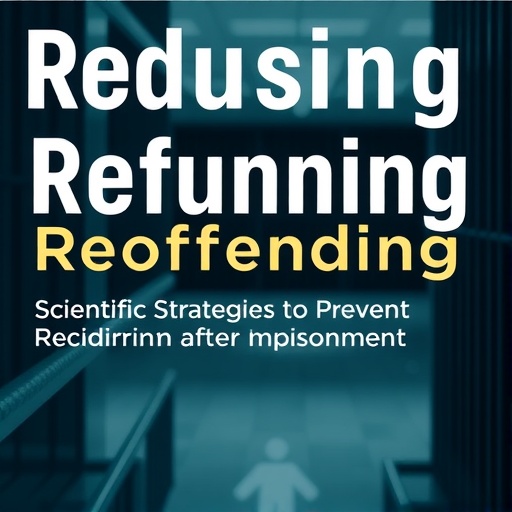In Norway, a country lauded internationally for its humane and rehabilitative prison system, the persistence of recidivism—the tendency for individuals to reoffend after serving their sentences—remains a perplexing issue. Despite comprehensive social benefits and a justice system designed to support reintegration, a significant number of former inmates reenter the criminal justice system. This paradox has recently come under scrutiny in a groundbreaking master’s thesis in cybernetics by Olea Linnea Andersson at the Norwegian University of Science and Technology (NTNU), which dives deep into systemic barriers and overlooked factors influencing recidivism.
Traditionally, predictions about recidivism risk have focused narrowly on concrete, measurable variables such as prior criminal records, substance abuse issues, and behavioral patterns observed during incarceration. These “hard” indicators form the backbone of risk assessments employed by correctional institutions worldwide. However, Andersson’s research challenges this long-established paradigm by illuminating a constellation of “soft” factors—mental health, quality of interpersonal relationships, personal motivation, systemic support during the critical transition phase after release, and organizational flow of resources—that play equally, if not more, pivotal roles in determining whether former inmates successfully reintegrate.
What makes Andersson’s approach unique is her application of cybernetics, the interdisciplinary study of systems, control, and communication, to analyze recidivism not as isolated individual failures but as emergent properties of interactions between people and fragmented institutional systems. Instead of examining inmates’ attributes in a vacuum, she adopts a holistic, system-wide perspective that encompasses their life course from pre-birth influences to school years, through addiction, conviction, imprisonment, and life post-release. This broad temporal and systemic scope forms the foundation for a comprehensive model capable of capturing the dynamic interplay between individual capacities and external supports.
A particularly novel concept introduced in the thesis is that of “augmented grit.” Extending beyond conventional notions of simple willpower or determination, augmented grit encompasses a complex synthesis of self-regulation skills, hopeful outlook, robust social support networks, and systemic environments that provide real opportunities for change. Andersson’s analyses reveal that inmates exhibiting high levels of augmented grit are statistically less likely to recidivate—but crucially, only if the encompassing social and institutional systems engage meaningfully to support the transition back into society.
This insight throws light on why motivation alone—long championed in prisoner rehabilitation programs—often fails to translate into sustainable desistance from crime. Without coordinated external supports such as stable housing, accessible healthcare, employment assistance, and continued mental health services, the internal drive of former inmates is insufficient to break the cycle. The research identifies systemic fragmentation as a key barrier: Norwegian welfare, healthcare, and correctional services largely operate in silos, resulting in discontinuities in care and missed opportunities to reinforce positive behaviors during the vulnerable reentry phase.
Using advanced artificial intelligence techniques, Andersson developed a predictive model that integrates both traditional quantitative data and qualitative insights derived from interviews with inmates and correctional officers. This model not only gauges the risk of recidivism with greater accuracy but also maps the structural connections—and disconnections—between the disparate service providers. By revealing where the system is failing and pinpointing leverage points for intervention, it offers a practical tool for policymakers seeking to optimize rehabilitation strategies and allocate resources more effectively.
Her findings suggest that rather than viewing recidivism as a cyclical inevitability, we should conceptualize it as a modifiable spiral—one that can ascend towards reintegration and societal contribution given the right inputs. This reframing has profound implications for how societies design correctional and post-release services. It advocates for data-driven, interconnected systems that treat former prisoners as whole individuals embedded in complex life ecosystems, rather than as discrete cases defined by criminal history alone.
The incorporation of systems thinking and cybernetic principles into criminal justice research exemplifies a forward-thinking methodological innovation. It challenges entrenched siloed bureaucracies by emphasizing the necessity of communication, data sharing, and coordinated action across different government branches and social services. Such a transition is essential to transform abstract policy goals of reducing recidivism into tangible, measurable outcomes that benefit individuals and communities alike.
Andersson’s work also highlights the critical data gaps hindering progress. Currently, there is insufficient collection and integration of information about mental health statuses, social relationships, motivation levels, and system responsiveness across agencies. This “flying blind” scenario limits the ability to identify what interventions work best and under which conditions, making it difficult to continuously refine rehabilitation programs.
Moreover, the research underlines the ethical imperative of using artificial intelligence not as a tool of control or surveillance, but as an enabler of human-centered support systems. By designing AI models that respect the dignity and agency of former prisoners, the approach aligns technological advancement with social justice goals, thus advancing both scientific and humanitarian objectives.
Ultimately, this pioneering thesis from NTNU represents a significant step forward in understanding and addressing the complex, systemic nature of recidivism. It underscores the value of embracing interdisciplinary frameworks to tackle entrenched social challenges, illustrating how cybernetics and AI can enrich criminology and public policy. For Norway, and potentially the wider international community, this research charts a promising path toward creating spirals of success, breaking the cycle of reoffending, and giving individuals genuinely new chances at life.
Subject of Research: Recidivism and systemic barriers in the Norwegian correctional system analyzed through a societal cybernetic approach.
Article Title: A Societal Cybernetic Analysis of Recidivism and Systemic Barriers in the Norwegian Correctional System
Web References: https://ntnuopen.ntnu.no/ntnu-xmlui/handle/11250/3198242
References: Olea Linnea Andersson. A societal cybernetic analysis of recidivism and systemic barriers in the Norwegian correctional system.
Image Credits: Illustrative photo: Christian Wangberg / Norwegian Prison and Probation Service
Keywords: recidivism, augmented grit, cybernetics, Norwegian correctional system, artificial intelligence, social support, systemic barriers, rehabilitation, criminal justice, systemic fragmentation, mental health, coordinated care




